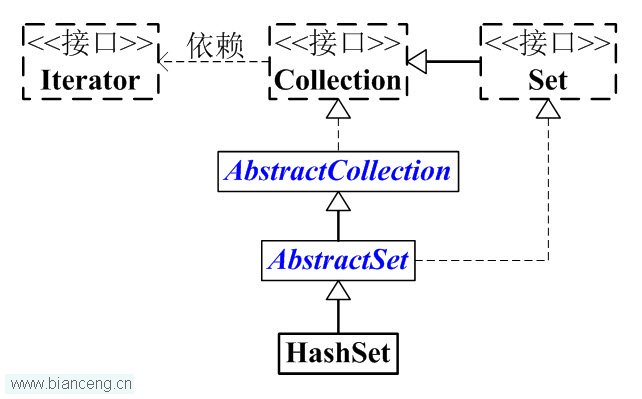這一章,我們對HashSet進行學習。
我們先對HashSet有個整體認識,然後再學習它的源碼,最後再通過實例來學會使用HashSet。
第1部分 HashSet介紹
HashSet 簡介
HashSet 是一個沒有重復元素的集合。
它是由HashMap實現的,不保證元素的順序,而且HashSet允許使用 null 元素。
HashSet是非同步的。如果多個線程同時訪問一個哈希 set,而其中至少一個線程修改了該 set,那麼它必須 保持外部同步。這通常是通過對自然封裝該 set 的對象執行同步操作來完成的。如果不存在這樣的對象,則應該使用 Collections.synchronizedSet 方法來“包裝” set。最好在創建時完成這一操作,以防止對該 set 進行意外的不同步訪問:
Set s = Collections.synchronizedSet(new HashSet(...));
HashSet通過iterator()返回的迭代器是fail-fast的。
HashSet的繼承關系如下:
java.lang.Object
java.util.AbstractCollection<E>
java.util.AbstractSet<E>
java.util.HashSet<E>
public class HashSet<E>
extends AbstractSet<E>
implements Set<E>, Cloneable, java.io.Serializable { }
HashSet與Map關系如下圖:

查看本欄目
HashSet的構造函數
// 默認構造函數
public HashSet()
// 帶集合的構造函數
public HashSet(Collection<? extends E> c)
// 指定HashSet初始容量和加載因子的構造函數
public HashSet(int initialCapacity, float loadFactor)
// 指定HashSet初始容量的構造函數
public HashSet(int initialCapacity)
// 指定HashSet初始容量和加載因子的構造函數,dummy沒有任何作用
HashSet(int initialCapacity, float loadFactor, boolean dummy)
HashSet的主要API
boolean add(E object) void clear() Object clone() boolean contains(Object object) boolean isEmpty() Iterator<E> iterator() boolean remove(Object object) int size()
第2部分 HashSet源碼解析
為了更了解HashSet的原理,下面對HashSet源碼代碼作出分析。
package java.util;
public class HashSet<E>
extends AbstractSet<E>
implements Set<E>, Cloneable, java.io.Serializable
{
static final long serialVersionUID = -5024744406713321676L;
// HashSet是通過map(HashMap對象)保存內容的
private transient HashMap<E,Object> map;
// PRESENT是向map中插入key-value對應的value
// 因為HashSet中只需要用到key,而HashMap是key-value鍵值對;
// 所以,向map中添加鍵值對時,鍵值對的值固定是PRESENT
private static final Object PRESENT = new Object();
// 默認構造函數
public HashSet() {
// 調用HashMap的默認構造函數,創建map
map = new HashMap<E,Object>();
}
// 帶集合的構造函數
public HashSet(Collection<? extends E> c) {
// 創建map。
// 為什麼要調用Math.max((int) (c.size()/.75f) + 1, 16),從 (c.size()/.75f) + 1 和 16 中選擇一個比較大的樹呢?
// 首先,說明(c.size()/.75f) + 1
// 因為從HashMap的效率(時間成本和空間成本)考慮,HashMap的加載因子是0.75。
// 當HashMap的“阈值”(阈值=HashMap總的大小*加載因子) < “HashMap實際大小”時,
// 就需要將HashMap的容量翻倍。
// 所以,(c.size()/.75f) + 1 計算出來的正好是總的空間大小。
// 接下來,說明為什麼是 16 。
// HashMap的總的大小,必須是2的指數倍。若創建HashMap時,指定的大小不是2的指數倍;
// HashMap的構造函數中也會重新計算,找出比“指定大小”大的最小的2的指數倍的數。
// 所以,這裡指定為16是從性能考慮。避免重復計算。
map = new HashMap<E,Object>(Math.max((int) (c.size()/.75f) + 1, 16));
// 將集合(c)中的全部元素添加到HashSet中
addAll(c);
}
// 指定HashSet初始容量和加載因子的構造函數
public HashSet(int initialCapacity, float loadFactor) {
map = new HashMap<E,Object>(initialCapacity, loadFactor);
}
// 指定HashSet初始容量的構造函數
public HashSet(int initialCapacity) {
map = new HashMap<E,Object>(initialCapacity);
}
HashSet(int initialCapacity, float loadFactor, boolean dummy) {
map = new LinkedHashMap<E,Object>(initialCapacity, loadFactor);
}
// 返回HashSet的迭代器
public Iterator<E> iterator() {
// 實際上返回的是HashMap的“key集合的迭代器”
return map.keySet().iterator();
}
public int size() {
return map.size();
}
public boolean isEmpty() {
return map.isEmpty();
}
public boolean contains(Object o) {
return map.containsKey(o);
}
// 將元素(e)添加到HashSet中
public boolean add(E e) {
return map.put(e, PRESENT)==null;
}
// 刪除HashSet中的元素(o)
public boolean remove(Object o) {
return map.remove(o)==PRESENT;
}
public void clear() {
map.clear();
}
// 克隆一個HashSet,並返回Object對象
public Object clone() {
try {
HashSet<E> newSet = (HashSet<E>) super.clone();
newSet.map = (HashMap<E, Object>) map.clone();
return newSet;
} catch (CloneNotSupportedException e) {
throw new InternalError();
}
}
// java.io.Serializable的寫入函數
// 將HashSet的“總的容量,加載因子,實際容量,所有的元素”都寫入到輸出流中
private void writeObject(java.io.ObjectOutputStream s)
throws java.io.IOException {
// Write out any hidden serialization magic
s.defaultWriteObject();
// Write out HashMap capacity and load factor
s.writeInt(map.capacity());
s.writeFloat(map.loadFactor());
// Write out size
s.writeInt(map.size());
// Write out all elements in the proper order.
for (Iterator i=map.keySet().iterator(); i.hasNext(); )
s.writeObject(i.next());
}
// java.io.Serializable的讀取函數
// 將HashSet的“總的容量,加載因子,實際容量,所有的元素”依次讀出
private void readObject(java.io.ObjectInputStream s)
throws java.io.IOException, ClassNotFoundException {
// Read in any hidden serialization magic
s.defaultReadObject();
// Read in HashMap capacity and load factor and create backing HashMap
int capacity = s.readInt();
float loadFactor = s.readFloat();
map = (((HashSet)this) instanceof LinkedHashSet ?
new LinkedHashMap<E,Object>(capacity, loadFactor) :
new HashMap<E,Object>(capacity, loadFactor));
// Read in size
int size = s.readInt();
// Read in all elements in the proper order.
for (int i=0; i<size; i++) {
E e = (E) s.readObject();
map.put(e, PRESENT);
}
}
}
說明:
HashSet的代碼實際上非常簡單,通過上面的注釋應該很能夠看懂。它是通過HashMap實現的,若對HashSet的理解有困難,建議先學習以下HashMap;學完HashMap之後,在學習HashSet就非常容易了。
第3部分 HashSet遍歷方式
3.1 通過Iterator遍歷HashSet
第一步:根據iterator()獲取HashSet的迭代器。
第二步:遍歷迭代器獲取各個元素。
// 假設set是HashSet對象
for(Iterator iterator = set.iterator();
iterator.hasNext(); ) {
iterator.next();
}
3.2 通過for-each遍歷HashSet
第一步:根據toArray()獲取HashSet的元素集合對應的數組。
第二步:遍歷數組,獲取各個元素。
// 假設set是HashSet對象,並且set中元素是String類型
String[] arr = (String[])set.toArray(new String[0]);
for (String str:arr)
System.out.printf("for each : %s\n", str);
HashSet的遍歷測試程序如下:
import java.util.Random;
import java.util.Iterator;
import java.util.HashSet;
/*
* @desc 介紹HashSet遍歷方法
*
* @author skywang
*/
public class HashSetIteratorTest {
public static void main(String[] args) {
// 新建HashSet
HashSet set = new HashSet();
// 添加元素 到HashSet中
for (int i=0; i<5; i++)
set.add(""+i);
// 通過Iterator遍歷HashSet
iteratorHashSet(set) ;
// 通過for-each遍歷HashSet
foreachHashSet(set);
}
/*
* 通過Iterator遍歷HashSet。推薦方式
*/
private static void iteratorHashSet(HashSet set) {
for(Iterator iterator = set.iterator();
iterator.hasNext(); ) {
System.out.printf("iterator : %s\n", iterator.next());
}
}
/*
* 通過for-each遍歷HashSet。不推薦!此方法需要先將Set轉換為數組
*/
private static void foreachHashSet(HashSet set) {
String[] arr = (String[])set.toArray(new String[0]);
for (String str:arr)
System.out.printf("for each : %s\n", str);
}
}
第4部分 HashSet示例
下面我們通過實例學習如何使用HashSet
import java.util.Iterator;
import java.util.HashSet;
/*
* @desc HashSet常用API的使用。
*
* @author skywang
*/
public class HashSetTest {
public static void main(String[] args) {
// HashSet常用API
testHashSetAPIs() ;
}
/*
* HashSet除了iterator()和add()之外的其它常用API
*/
private static void testHashSetAPIs() {
// 新建HashSet
HashSet set = new HashSet();
// 將元素添加到Set中
set.add("a");
set.add("b");
set.add("c");
set.add("d");
set.add("e");
// 打印HashSet的實際大小
System.out.printf("size : %d\n", set.size());
// 判斷HashSet是否包含某個值
System.out.printf("HashSet contains a :%s\n", set.contains("a"));
System.out.printf("HashSet contains g :%s\n", set.contains("g"));
// 刪除HashSet中的“e”
set.remove("e");
// 將Set轉換為數組
String[] arr = (String[])set.toArray(new String[0]);
for (String str:arr)
System.out.printf("for each : %s\n", str);
// 新建一個包含b、c、f的HashSet
HashSet otherset = new HashSet();
otherset.add("b");
otherset.add("c");
otherset.add("f");
// 克隆一個removeset,內容和set一模一樣
HashSet removeset = (HashSet)set.clone();
// 刪除“removeset中,屬於otherSet的元素”
removeset.removeAll(otherset);
// 打印removeset
System.out.printf("removeset : %s\n", removeset);
// 克隆一個retainset,內容和set一模一樣
HashSet retainset = (HashSet)set.clone();
// 保留“retainset中,屬於otherSet的元素”
retainset.retainAll(otherset);
// 打印retainset
System.out.printf("retainset : %s\n", retainset);
// 遍歷HashSet
for(Iterator iterator = set.iterator();
iterator.hasNext(); )
System.out.printf("iterator : %s\n", iterator.next());
// 清空HashSet
set.clear();
// 輸出HashSet是否為空
System.out.printf("%s\n", set.isEmpty()?"set is empty":"set is not empty");
}
}